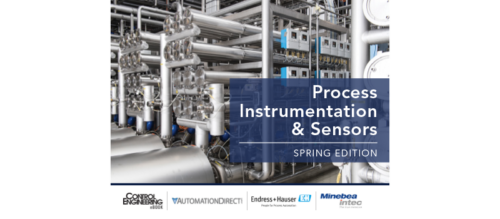Tuning surge tank level control loops
This type of PID loop has a different objective than most, which calls for a different strategy.
While almost all PID loop tuning rules that have been developed aim for fast response, even the IMC and Lambda rules fall short of providing good tuning settings for a surge tank control loop, so we need to consider a different strategy for this application.
As shown in Figure 1, a surge tank is placed between two processing units to absorb flow rate fluctuations coming from the upstream process, so that the flow rate to the downstream process changes less rapidly. To do this, the tank level has to go up and down; therefore, the level controller must allow this movement and not try to hold the level close to its setpoint. The controller should simply keep the surge tank’s level between its upper and lower limits, and do this with the least possible amount of change to its output.
The level-averaging method for controlling the surge tank level is preferred by most operators and engineers. This method minimizes control valve movement during disturbances, keeps the level between its limits, and brings the level back to setpoint over the long term.
The tuning rule describes how to tune surge tank level controls using the level-averaging method and is designed for use on a non-interactive controller algorithm with its integral time set in minutes, such as the algorithm in the Dataforth MAQ20 system.
Tuning procedure
To tune the controller for level-averaging control, the residence time of the surge tank, the greatest expected change in flow rate, and the maximum allowable deviation from setpoint must be known.
Residence time (tres): Residence time is the time it will take the tank to drain from 100% to 0% level if there is no incoming flow and the outlet valve is 100% open. It can be calculated by dividing the volume of the vessel between 0% and 100% of its level measurement span (V) by the maximum flow rate with the outlet valve wide open (Qmax):
tres = V / Qmax
The same unit of measure must be used for volume in V and Qmax, and Qmax must be expressed in volume per minute.
Change in flow rate (Δfmax): The greatest expected change in flow rate should be expressed as a percentage of maximum valve capacity. If available, historical trends of the level control valve’s position can be used to find the largest change the controller output has made over a relatively short period of time.
Maximum deviation from setpoint (ΔLmax): The maximum allowable deviation of level from its setpoint should be specified as a percentage of the full span of the level measurement.
Tuning equations
Once the three quantities described above are available, tuning settings can be calculated for the controller:
KC = 0.74 Δfmax / ΔLmax
TI = 4 tres / KC
TD = 0
Where KC is controller gain; TI is integral time in minutes; and TD is derivative time. The typical response of a surge tank tuned with this level-averaging tuning rule is shown in Figure 2.
Although Ziegler-Nichols and most other tuning methods for level controllers are not suitable for use on surge tanks, the level-averaging tuning rule will keep the tank’s level between its upper and lower limits with the least possible amount of change to the controller’s output.
Lee Payne is CEO at Dataforth.
ONLINE
For more information, visit:
Subscribe to Process & Advanced Control eNewsletter at www.controleng.com/newsletters
Do you have experience and expertise with the topics mentioned in this content? You should consider contributing to our CFE Media editorial team and getting the recognition you and your company deserve. Click here to start this process.


